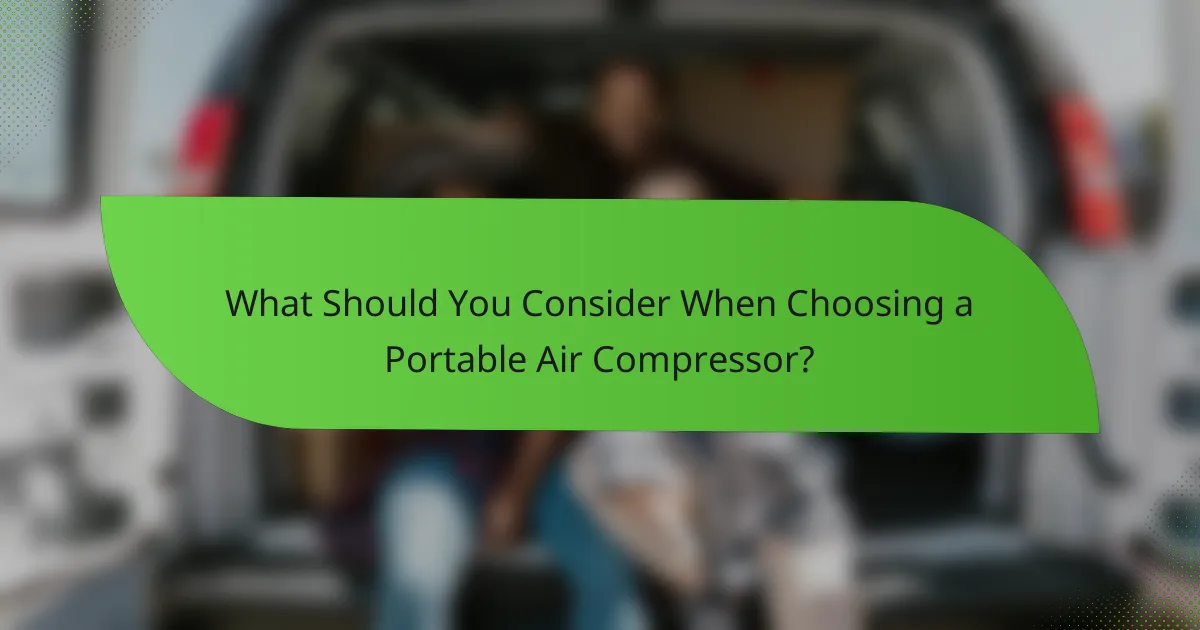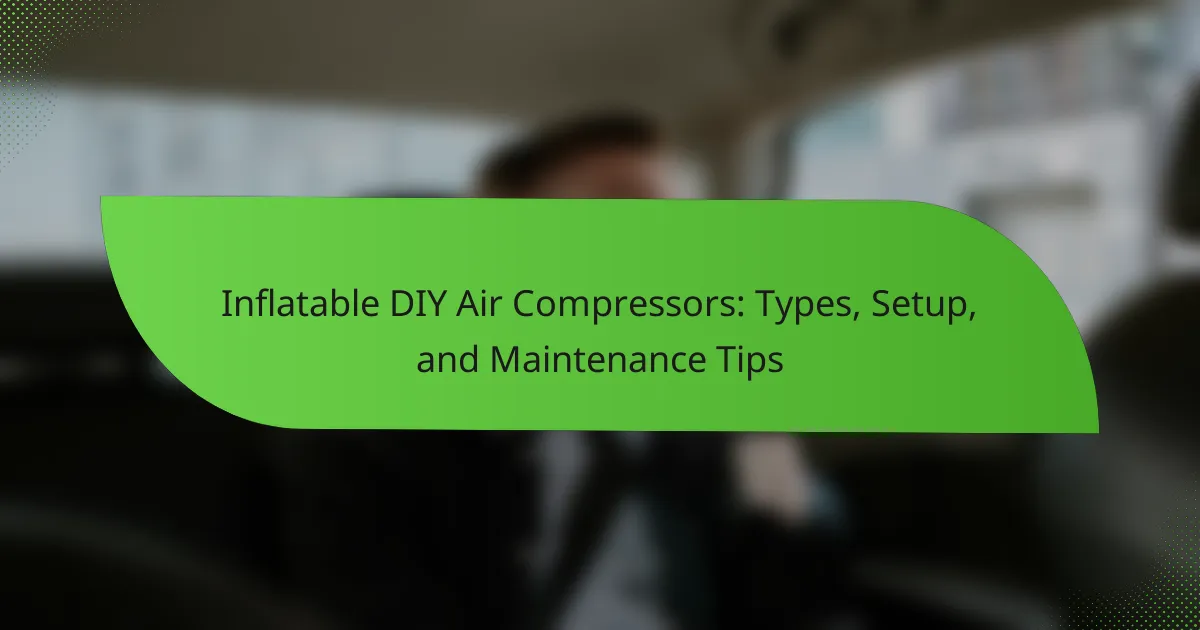Choosing the right portable air compressor involves evaluating three primary factors: size, power, and intended use. Size influences portability and storage, with lightweight models being easier to transport. Power specifications, including PSI (pounds per square inch) and CFM (cubic feet per minute), determine the compressor’s efficiency and suitability for various tasks. Understanding the specific requirements of your tools is essential for optimal performance. Additionally, considerations such as tank capacity and noise level can impact the usability of the compressor in different environments.

What Should You Consider When Choosing a Portable Air Compressor?
When choosing a portable air compressor, consider size, power, and intended use. Size affects portability and storage. A lightweight model is easier to transport. Power determines the compressor’s efficiency. Higher PSI ratings indicate greater power for demanding tasks. Intended use dictates the necessary features. For inflating tires, a smaller compressor suffices. For powering tools, select a model with higher CFM ratings. Additionally, check tank capacity for longer operation without refilling. Noise level may also be important for residential areas. Finally, assess the brand’s reputation for reliability and customer service.
How does size impact the effectiveness of a portable air compressor?
The size of a portable air compressor directly impacts its effectiveness in several ways. Larger compressors typically have higher tank capacities, allowing for more air storage. This enables them to deliver air at a consistent pressure for longer durations. Smaller compressors are more portable but may require frequent refilling, which can interrupt use. Additionally, larger units often feature more powerful motors, resulting in faster inflation times. Conversely, smaller compressors may struggle with high-demand tasks, such as inflating large tires or powering pneumatic tools. Therefore, the size of a portable air compressor influences its air delivery capacity, pressure consistency, and suitability for specific applications.
What are the standard sizes available for portable air compressors?
Standard sizes for portable air compressors typically range from 1 gallon to 6 gallons. Most common sizes include 1-gallon, 2-gallon, 3-gallon, 4-gallon, and 6-gallon models. The 1-gallon compressor is ideal for small tasks like inflating tires. The 2-gallon and 3-gallon sizes are suitable for light-duty applications, such as powering small tools. The 4-gallon and 6-gallon compressors can handle more demanding tasks, including spray painting and powering air tools. These sizes are designed to balance portability with the required air pressure and volume for various uses.
How does size correlate with portability and storage options?
Size directly affects both portability and storage options of portable air compressors. Smaller compressors are generally lighter and easier to carry. This enhances their portability, making them suitable for mobile use. Larger compressors often provide more power but can be cumbersome to transport. They may require dedicated storage space due to their dimensions. A compact design allows for easier storage in tight spaces, such as car trunks or closets. Conversely, larger models may not fit in these areas, limiting their storage options. Therefore, selecting the right size is crucial for balancing portability and storage capabilities.
What role does power play in the performance of a portable air compressor?
Power significantly influences the performance of a portable air compressor. It determines the compressor’s ability to generate airflow and pressure. Higher power ratings typically lead to increased efficiency and faster inflation times. Compressors with greater power can handle larger tasks, such as powering pneumatic tools. For instance, a 1.5 HP compressor can provide higher PSI and CFM than a 0.5 HP model. This capability is essential for applications requiring continuous air supply. Additionally, power affects the compressor’s duty cycle, indicating how long it can operate before needing a rest. In summary, power is a critical factor in determining the effectiveness and versatility of a portable air compressor.
What are the different power ratings for portable air compressors?
Portable air compressors typically have power ratings ranging from 1 to 6 horsepower (HP). The most common ratings are 1 HP, 2 HP, 3 HP, and 5 HP. Some models may also be rated in terms of watts, with values such as 750 watts to 4500 watts. The power rating affects the compressor’s airflow capacity and pressure output. For instance, a 1 HP compressor generally provides around 3-4 CFM (cubic feet per minute) at 90 PSI (pounds per square inch). Higher-rated compressors, like those at 5 HP, can deliver more than 20 CFM at similar pressures. These ratings help users select a compressor suitable for their specific tasks, such as inflating tires, powering pneumatic tools, or spray painting.
How does power affect the compressor’s ability to handle various tasks?
Power directly influences a compressor’s capacity to perform tasks effectively. Higher power ratings enable compressors to generate greater air pressure and volume. This allows them to handle demanding applications such as inflating tires or powering pneumatic tools. Conversely, lower power limits a compressor’s efficiency in high-demand situations. For example, a 3 HP compressor can typically support multiple tools simultaneously, while a 1 HP unit may struggle with even one. Additionally, power affects recovery time; more powerful compressors refill their tanks faster. Therefore, selecting a compressor with adequate power is essential for meeting specific task requirements.
Why is intended use important when selecting a portable air compressor?
Intended use is crucial when selecting a portable air compressor because it determines the compressor’s specifications and features. Different applications require varying levels of power and airflow. For instance, inflating tires requires less power than powering pneumatic tools. Selecting a compressor based on intended use ensures efficiency and effectiveness. A compressor with insufficient power may not perform adequately for heavy-duty tasks. Conversely, an overpowered model may lead to unnecessary expenses. Understanding the intended use allows users to choose the right size and capacity. This tailored selection enhances user satisfaction and operational success.
What are the common applications for portable air compressors?
Portable air compressors are commonly used in various applications. These applications include inflating tires for vehicles, bicycles, and sports equipment. They are also utilized for powering pneumatic tools, such as nail guns and impact wrenches. Additionally, portable air compressors serve in painting and airbrushing tasks. They assist in cleaning and drying surfaces by providing a stream of compressed air. Moreover, they are effective for operating air-powered devices in construction and maintenance work. Many portable air compressors are designed for home use, making them accessible for DIY projects. Their versatility makes them valuable in both professional and personal settings.
How do different uses dictate the required features of an air compressor?
Different uses dictate the required features of an air compressor by influencing its size, power, and pressure output. For instance, automotive applications often require a portable compressor with 90-120 PSI to inflate tires efficiently. In contrast, industrial uses may demand a larger, stationary compressor capable of delivering higher CFM (cubic feet per minute) for tools like sanders or spray guns.
Construction sites require rugged compressors with durability and mobility, while home use might prioritize smaller, quieter models for tasks like inflating sports equipment. The specific tools intended for use also affect the compressor’s features. For example, pneumatic nail guns need a compressor that can maintain consistent pressure for effective operation.
Overall, the intended application determines the necessary specifications, ensuring optimal performance and efficiency.

How Can You Determine the Right Size for Your Needs?
To determine the right size for your needs, assess the air compressor’s CFM (Cubic Feet per Minute) rating. This rating indicates the volume of air the compressor can deliver. Identify the tools you plan to use and their required CFM ratings. For example, a nail gun typically requires 2-3 CFM, while a spray gun may need 10-15 CFM. Ensure the compressor’s CFM exceeds the total requirements of your tools. Additionally, consider the tank size; a larger tank can provide a steady air supply for extended use. A tank capacity of 4-6 gallons is suitable for light tasks, while 8 gallons or more is better for heavy-duty applications. Finally, evaluate the portability of the compressor based on your usage environment. If frequent movement is necessary, a lightweight model is ideal.
What factors influence the size you should choose?
The size of a portable air compressor should be influenced by several key factors. First, the intended use determines the required size. For instance, inflating tires requires a smaller unit, while powering tools may need a larger compressor. Second, the air pressure requirements impact size selection. Higher pressure demands necessitate larger compressors. Third, the airflow rate, measured in CFM (cubic feet per minute), is crucial. Tools with higher CFM ratings require bigger compressors for optimal performance. Fourth, portability is a factor. Smaller compressors are easier to transport but may lack power. Lastly, storage space available can limit size options. Each of these factors plays a critical role in choosing the appropriate size for a portable air compressor.
How does the frequency of use affect size selection?
Frequency of use significantly influences size selection for portable air compressors. Frequent users typically require larger compressors for higher air output. Larger compressors can deliver more consistent pressure and volume over extended periods. In contrast, occasional users may opt for smaller, more portable models. Smaller compressors are easier to transport and store. They also consume less power, making them cost-effective for infrequent tasks. Ultimately, the choice of size should align with the intended frequency of use. Users should assess their specific needs to ensure optimal performance and efficiency.
What specific tasks require larger or smaller compressors?
Larger compressors are required for heavy-duty tasks such as powering pneumatic tools, spray painting, and sandblasting. These tasks demand high airflow and pressure, typically exceeding 10 CFM at 90 PSI. Smaller compressors are suitable for lighter tasks like inflating tires, running small nail guns, or powering airbrushes. These applications generally require less airflow, often around 2-5 CFM at 90 PSI. The size of the compressor directly correlates with the tool’s requirements. For example, a framing nailer needs around 2.5 CFM, while a paint sprayer may require up to 12 CFM. Therefore, matching the compressor size to the specific task ensures efficiency and optimal performance.
How can you measure the space available for your air compressor?
To measure the space available for your air compressor, first determine the dimensions of the compressor. Measure the length, width, and height of the compressor using a tape measure. Next, identify the area where you plan to place the compressor. Measure the length and width of that space as well.
Ensure there is enough clearance around the compressor for ventilation and maintenance. A minimum of 12 inches of space around the unit is recommended for proper airflow.
Finally, compare the compressor dimensions with the available space dimensions. Confirm that the compressor will fit comfortably in the designated area without obstruction.
What are the best practices for measuring and planning for air compressor storage?
The best practices for measuring and planning for air compressor storage include assessing space requirements, ensuring proper ventilation, and considering accessibility. Measure the dimensions of the storage area to confirm that the compressor fits comfortably. Maintain at least 12 inches of clearance around the compressor for airflow. Ventilation is crucial to prevent overheating and moisture buildup. Ensure the location is dry to avoid rust and damage. Plan for easy access to the compressor for maintenance and operation. Consider installing shelving or storage units for accessories and tools. Regularly check the storage area for any signs of wear or environmental damage. These practices enhance the longevity and efficiency of air compressor storage.

What Are the Key Power Specifications to Look For?
Key power specifications to look for in a portable air compressor include horsepower, PSI, and CFM. Horsepower indicates the motor’s strength, affecting performance. A higher horsepower typically means more power for heavy tasks. PSI, or pounds per square inch, measures the air pressure output. Higher PSI allows for more demanding applications. CFM, or cubic feet per minute, measures the airflow rate. A higher CFM ensures tools operate efficiently. For instance, a compressor with 2 HP, 150 PSI, and 4 CFM can handle various tasks effectively. These specifications directly influence the compressor’s suitability for specific uses.
How do PSI and CFM ratings affect performance?
PSI (Pounds per Square Inch) and CFM (Cubic Feet per Minute) ratings are critical for air compressor performance. PSI measures the pressure output of the compressor. Higher PSI ratings indicate the ability to power tools that require more pressure. CFM measures the volume of air the compressor can deliver. A higher CFM rating allows for continuous operation of air tools. Tools like nail guns may require lower PSI but higher CFM for efficiency. Conversely, impact wrenches need higher PSI to function effectively. The combination of adequate PSI and CFM ensures optimal performance for specific tasks. For example, a compressor with 90 PSI and 5 CFM can efficiently operate most pneumatic tools. Understanding these ratings helps users choose the right compressor for their needs.
What is the significance of PSI in portable air compressors?
PSI, or pounds per square inch, is a crucial measurement in portable air compressors. It indicates the pressure at which the compressor can deliver air. Higher PSI ratings allow for the inflation of larger tires and the operation of more demanding tools. For instance, many air tools require a minimum PSI to function effectively. Commonly, tire inflation needs around 30-35 PSI. Additionally, compressors with a higher PSI can handle various applications, from inflating sports equipment to powering pneumatic tools. Thus, understanding PSI helps users select the right compressor for their specific needs.
How does CFM relate to the compressor’s efficiency in different tasks?
CFM, or cubic feet per minute, directly relates to a compressor’s efficiency in various tasks. It measures the airflow rate produced by the compressor. Higher CFM values typically indicate better performance for demanding tasks. For instance, tools requiring more air, such as paint sprayers or sanders, perform optimally with compressors that have a higher CFM. Conversely, low-demand tasks, like inflating tires, need lower CFM ratings. Efficiency also depends on matching the CFM output to the tool’s requirements. If the CFM is insufficient, the compressor will struggle, leading to reduced performance. Thus, selecting a compressor with adequate CFM for specific tasks enhances efficiency and effectiveness.
What power sources are available for portable air compressors?
Portable air compressors can be powered by several sources. The main power sources include electricity, gasoline, and batteries. Electric portable air compressors typically require a standard outlet and are suitable for indoor use. Gasoline-powered models offer greater mobility and are ideal for outdoor applications. Battery-operated compressors provide convenience for remote locations without access to electricity. Each power source has its advantages depending on the intended use and environment.
What are the advantages and disadvantages of electric vs. gas-powered compressors?
Electric compressors are quieter and more efficient, while gas-powered compressors offer greater portability and power. Electric compressors typically require a power source, limiting their use in remote areas. They also produce less emissions and noise, making them suitable for indoor use. Gas-powered compressors, on the other hand, can operate anywhere without needing electricity. They are often more powerful, handling larger tasks effectively. However, they produce emissions and noise, which can be a drawback in residential areas. Additionally, gas-powered units require more maintenance due to their engines.

What Should You Keep in Mind for Your Intended Use?
When considering your intended use for a portable air compressor, focus on power requirements and air delivery. Different applications demand varying air pressures and flow rates. For example, inflating tires typically requires less power than powering pneumatic tools. Assess the specific PSI (pounds per square inch) and CFM (cubic feet per minute) needed for your tasks. Compatibility with your tools is crucial; ensure the compressor meets their specifications. Additionally, consider portability features like weight and size for ease of transport. Understanding these factors ensures optimal performance and efficiency for your intended applications.
How do different applications require specific features?
Different applications require specific features in portable air compressors to meet diverse needs. For instance, automotive applications need compressors with high PSI for tire inflation. These compressors typically feature portability for on-the-go use. In contrast, industrial applications demand higher CFM ratings for powering tools. Such compressors often include larger tanks for extended operation. Additionally, DIY home projects may require lightweight models with easy-to-use controls. These models prioritize user-friendliness and versatility. Each application’s requirements dictate the necessary features, ensuring optimal performance and efficiency.
What features are essential for home use versus professional use?
Home use air compressors typically require lower power and portability. They are designed for tasks like inflating tires or powering small tools. Features such as lightweight design and quieter operation are essential. In contrast, professional use air compressors demand higher power and durability. These compressors are built for heavy-duty applications like spray painting or pneumatic tools. Features like larger tank capacity and faster recovery time are crucial for efficiency. Home compressors often range from 1 to 3 horsepower, while professional models can exceed 5 horsepower. The difference in intended use dictates the necessary features for optimal performance.
How can you prioritize features based on your specific tasks?
Prioritizing features involves assessing the specific tasks the portable air compressor will perform. Start by identifying the most critical tasks required for your intended use. Next, rank features based on their relevance to those tasks. Consider factors like size, power, and portability, as they directly impact performance. Evaluate the frequency and intensity of the tasks to determine which features are essential. For example, if high power is crucial for frequent heavy-duty tasks, prioritize compressors with higher PSI ratings. Lastly, review user feedback and expert recommendations to validate your choices. This structured approach ensures that the selected features align with your specific operational needs.
What are the common mistakes to avoid when choosing a portable air compressor?
Common mistakes to avoid when choosing a portable air compressor include selecting the wrong size. Choosing a compressor that is too small may not meet your air pressure needs. Conversely, a compressor that is too large can be cumbersome and inefficient for small tasks. Another mistake is ignoring the power source. Some compressors are electric, while others run on gas. It’s essential to choose a power source that aligns with your intended usage. Failing to consider the intended use is also a frequent error. Different tasks require different airflow rates and pressure levels. Lastly, overlooking maintenance requirements can lead to premature failure. Regular upkeep is crucial for longevity and performance.
How can understanding your needs prevent overspending or underperformance?
Understanding your needs helps prevent overspending or underperformance by ensuring you select the right portable air compressor. When you identify your specific requirements, you can choose a model that matches your tasks. This alignment reduces the risk of purchasing unnecessary features or underpowered equipment. For example, knowing the PSI and CFM needed for your projects allows you to avoid overpaying for excessive capacity. Conversely, selecting a compressor with insufficient power can lead to ineffective performance. Research indicates that 70% of consumers experience buyer’s remorse due to mismatched product specifications. Thus, a clear understanding of your needs directly influences cost-effectiveness and efficiency in usage.
What tips can help you select the best portable air compressor for your needs?
Determine the required PSI and CFM for your tasks to select the best portable air compressor. PSI measures the pressure output, while CFM indicates airflow. Choose a model that meets or exceeds these requirements. Consider the tank size for storage capacity. A larger tank allows for longer use without refilling. Evaluate the weight and portability features, especially if you need to transport it frequently. Look for essential features like noise level and power source compatibility. Electric compressors are quieter, while gas models offer more power. Check user reviews for reliability and performance insights. Brands with good warranties often indicate quality assurance.
The main entity of the article is the portable air compressor, which is essential for various applications such as inflating tires and powering pneumatic tools. Key considerations when choosing a portable air compressor include size, power, and intended use, as these factors significantly impact performance and efficiency. The article discusses how size affects portability and storage, the importance of power ratings such as PSI and CFM, and how different applications dictate the necessary features of a compressor. Additionally, it addresses common mistakes to avoid and offers tips for selecting the best model based on specific needs.



